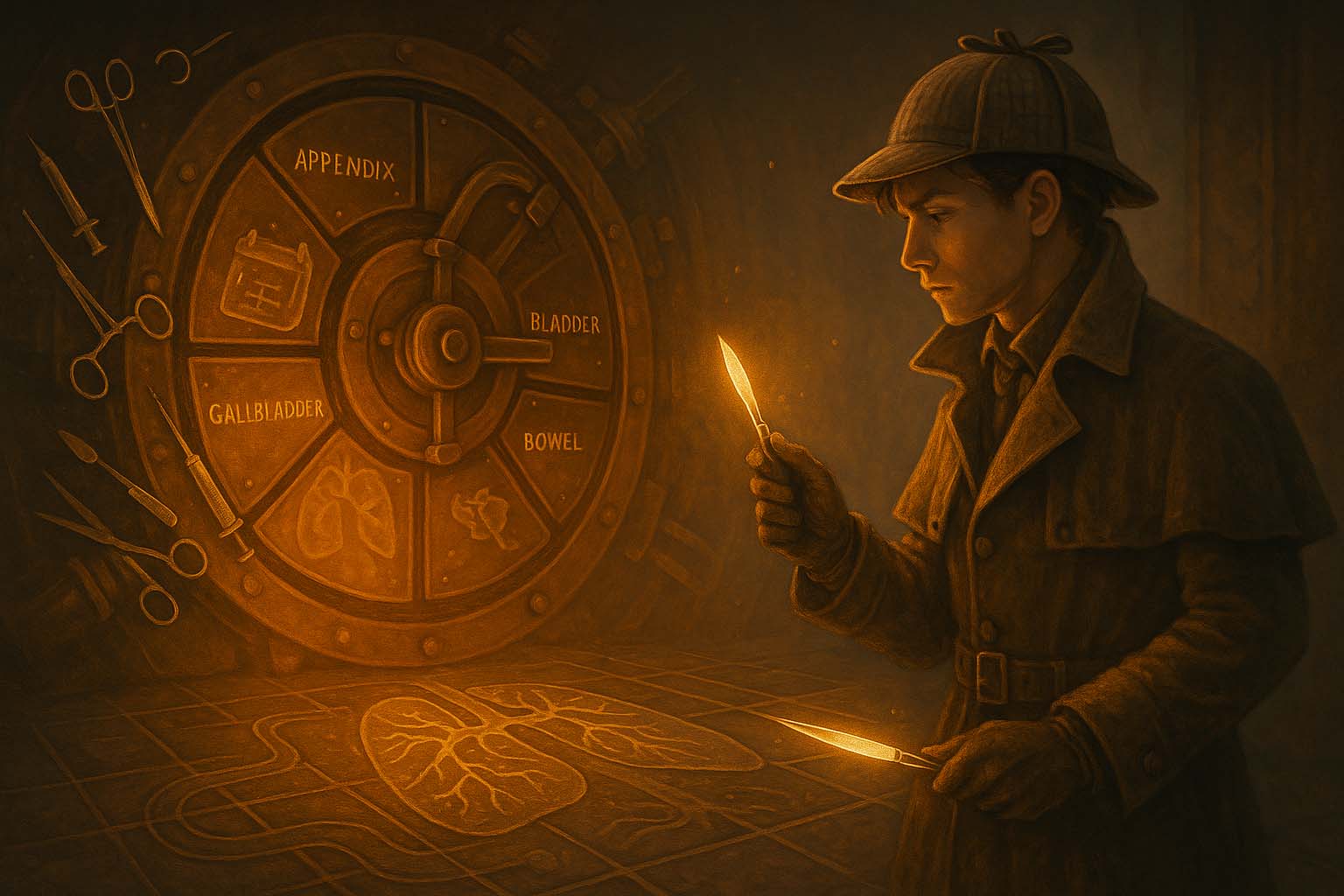
General Surgery
- Posted by admin
- Categories Core Surgical Specialties
- Date May 24, 2025
- Comments 0 comment
The Blade Detective’s Domain - Cracking the Cases of Cuts, Crises, and Quiet Confidence
1. Introduction: The Scene of the Specialty
Step into the shoes of a General Surgery sleuth.
This is where medicine meets steel—where diagnosis culminates in incision. General surgeons are detectives with scalpels, investigators of pain, lumps, and leaks. Their cases move fast: appendices burst, hernias bulge, gallbladders rage. In this high-stakes environment, there’s no time for hesitation, only decisive, deliberate action. Welcome to a world where each scar tells a story, and the knife, when guided by wisdom, restores what disease disrupts.
2. Key Mysteries They Solve (Common Conditions)
These detectives specialise in solving cases involving:
- Acute Abdomen – appendicitis, cholecystitis, bowel obstruction, and perforation.
- Hernias & Lumps – external signs of deeper dysfunction.
- Gastrointestinal Bleeding & Cancer – upper and lower GI mysteries with life-threatening potential.
- Trauma & Emergency Surgery – rapid interventions in critically injured patients.
Each case balances speed with scrutiny—diagnosing as you decide how and where to cut.
3. Their Trusted Tools & Techniques
Every detective has their kit—and in General Surgery, tools may include:
- Scalpel, Retractors, Sutures – classic instruments of precision and repair.
- Imaging Interpretation – CT, ultrasound, and X-ray used to map the battlefield.
- Laparoscopy – minimally invasive views of internal chaos.
- Operative Strategy – choosing the right approach, incision, and repair for each unique scenario.
This is detective work done with gloved hands and open fields of anatomy.
4. The Charms of This Field: Why It Captivates the Curious
- Immediate Impact: See the problem. Fix it. Save a life.
- Tactile Satisfaction: The physicality of diagnosis, repair, and closure.
- Team Leadership: Surgeons captain operating theatres and respond to crisis with clarity.
- Diverse Pathology: From skin to gut to gland, no day—or abdomen—is the same.
This is not just intervention—it’s intervention done under pressure, with purpose.
5. Challenges: The Toughest Cases They Face
- Unpredictable Presentations – Abdominal pain is a maze of overlapping signs.
- Operative Complications – Bleeding, infection, anastomotic leaks.
- Emotional Distance – Repeated trauma and death may tempt disengagement.
- Fatigue & Culture – Long hours, hierarchical traditions, and burnout risk.
But the seasoned surgeon knows: grace under pressure is the sharpest instrument of all.
6. Famous Cases and Hallmark Clues
- The “Classic Presentation” – Right lower quadrant pain with guarding: appendicitis.
- The “Zebra” – Intermittent bowel obstruction in a young woman: Meckel’s diverticulum.
- The “Aha Moment” – Gallstones seen on ultrasound, but the real cause of jaundice? A periampullary tumour.
7. Your Training Trail: How to Join the Investigation
To become a General Surgery detective:
- Build foundations in anatomy, acute medicine, and procedural skill.
- Train in emergency and elective theatres—watch, assist, then lead.
- Learn when not to operate—judgment is as important as technique.
- Practise with humility, resilience, and an appetite for lifelong technical mastery.
Whether managing trauma on call or resecting a bowel tumour with care, your decisions will carry weight in minutes and in lifetimes.
8. Final Words: The Signature of the General Surgery Detective
General Surgery detectives wield the blade with honour.
They think fast, act cleanly, and bear the responsibility of direct repair.
They live where medicine meets momentum—where critical thinking guides confident action.
So if you’re drawn to decisions made under light, through layers of tissue and tension—
then this is your theatre to enter.



